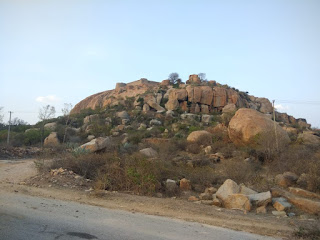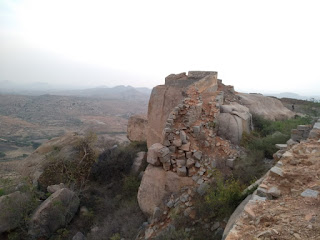Stars blanket at Gummanayaka Fort
Whenever I drove over north of my house towards Chikkabalapura and beyond, I always had a question, whats inside the hill ranges that lies to the east of Bagepalli town. I was invited by our civil engineer and construction partner Mr. Venkataramana many times to witness the development of a temple on a small hillock at his village Nallasanampalli. This time he had a concrete work for staircase that provides steps to the temple structure and called me for a visit, I took the maps and other forest department information to learn more on the geography and wildlife of this area and identify a suitable place for camping and small hike. Bagepalli taluk of Chikkaballapura district had a history of rulers related to Vijayanagara Empire and Tippu sultan that gave details of place called Gummanayaka Palya and a fort in it. Seeing on the maps, I could locate the Gummanayaka fort with difficulty and found that most of the North, West and South portion surrounding the fort were covered semi arid rocky hills and this created an interest in me to visit the place.
Ravi, Niranjan, Roshan, Adarsh and Divya Prasad accompanied me for the exploration camp to Gummanayaka fort and we started from Bangalore after lunch on my Mahindra Thar jeep and Adarsh's Duster. Ravi and Roshan had brought all the arrangement for cooking food at night camp and it was loaded in my vehicle. The route goes through the national highway till Bagepalli and nice country side road from there on wards till the Gummanayakana palli village which is where we parked our vehicle near a Maramma temple located at the base of the hillock that has the fort.
Some details I could get about fort says that
"Gummanayaka Fort in Bagepalli was founded by Byregowda a palyagara (chieftain of the Vijayanagara kingdom). Some of the remains of the past include the chieftain palace, hospital and elephant stable. The Sri Rama temple near the third gate of the fort has been neglected and has become a cattle shed. This fort is situated 16 kms east of Bagepalli, was founded around 1350 by a feudatory chieftain Gummanayaka and ruled for several years by him and his successors. It is noted for its fortified circular rock, that rises 150 ft above the surrounding hilly tract.
As many as 26 palegars ruled from this fort. They built temples dedicated to Sita, Rama, Lakshman and Hanuman. Today without the idols the temples have become orphans. At a time when cement was not in use, the temples have been constructed by joining boulders. Both inside and outside the Sri Rama temple, episodes from the Ramayana and Mahabharata have been carved in bas relief. An inscription in Telugu has been written in Kannada script on the wall. The garba gudi (santum sanctorum) is 15 ft in height and 8 ft wide is fashioned in the form of a tortoise. "
The battle of Talikota (1565) occurred during the rule of Viradasappa Nayaka (r. 1548-1584), the 19th polegar. While other Vijayanagar feudatories took advantage of this signal defeat to break free, "the poligar of Gummanayakana Palya, true to his traditional loyalty, remained firm under the banner of the fallen House of Vijayanagar." During the succession wars of the early 1630s, Palegar Vasanta Nayaka refused to acknowledge Emperor Venkata Deva Raya III. Immadi Kempe Gowda of Bangalore, the emperor champion, laid waste the palegar's lands and forced him to submit. But after some time, even tribute stopped being collected by the increasingly ineffective rulers of Vijayanagar, and Gummanayakana Palya came under Moghul rule during the reign of Bangara Thimma Nayaka (r. 1680-1728). His successor Kadarappa Nayaka III (r. 1728-1740) had to switch allegiance to the Marathas and pay heavy tribute to the Peshwa. Narasimha Nayaka V (r. 1740-1760) was forced to cede part of his territories to Murarirao Ghorpade of Gooty (q.v.) and was later brought under tribute to Hyder Ali of Mysore, who nevertheless befriended him against his own subordinates. Tippu Sultan, however, embarked on a systematic policy of extermination of the palegars. Several small principalities were annexed and, despite Palegar Narasimha Nayaka VI's (r. 1765-1802) "protestations of loyalty for generations to the Sultan of Mysore," his palayapat was invaded, the palegar and his family fleeing the country ahead of Tippu's troops. Narasimha was briefly restored during the Third Mysore War, but when peace was concluded in 1793, he was again dispossessed by the vengeful Tippu. During the Fourth Mysore War (1799), Narasimha Nayaka VI, with a large army of his own, joined the British in their final assault on Sringapatam. Promises made by the English commander to restore his palayapat after final victory over Tippu were not honored by Dewan Purneya of the restored Wadiyars of Mysore. Narasimha was forced to go into exile once more where he, the last Paligar to rule the ancient Palayapat [of] Gummanayakana Palya, died of grief."

Lake on the western side at the bottom of the hillock on which fort is constructed.

View of the fort from Gummanayakanapalya village






Photos of the group that visited the place




Nallachowdeshwari devi temple at Nallasanampalli Village notheast of Bagepalli and Gummanayaka fort.


Comments